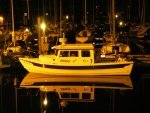JamesTXSD":bwh27fdr said:Hey, Foggy, thanks for quoting me. I guess you missed the part about unfamiliar water in the dark? Sure not something I try for.
This also gives me the opportunity to add: in any low visibility situation (foggy, rain, night), I run slow; displacement speed or slower. As a commercial boat driver, I don't always get to pick the weather or time of day. As a recreational boat guy, I can pick the time, but Mother Nature gets to decide the weather. Anyone who has been out for more than an afternoon is aware how fast weather can change. That also means being aware of every anchoring situation, including overnight. You may do a fine job of setting your anchor, but you have to be aware of what is around you, in case the need comes up to move - in the dark.
If one is cruising, you are going to be out in the dark. Best to understand how to deal with it rather than just say, "Don't do it."
As a non-current pilot with 4,000+ hours, commercial/multi-engine/instrument ratings, I am aware that pilots who are not IFR trained or current are cautioned to not get into IFR situations... that said, pilot training for a private license includes training for low visibility and recovery from unusual attitudes. Because things happen. Best to understand how to deal with low visibility and understand lighting (which was the OP's question).
Keeping good night vision is important, that's why "eyeballs" was at the top of my list. Radar for solid things. A hand-held spotlight to see things that might be right at the water's surface. Armed with knowledge and training, you use the available tools. We don't all have a Grandma to tell us when to come inside out of the dark.
For the record, both of my dear ol' Grandmas (long departed) were sweet as could be, but neither could drive a car, much less run a boat or fly an aircraft... if I always took their advice, I would have never left the neighborhood. :wink: Seems to me that people who quote their grandparents all the time are giving unsolicited advice, but make it seem like it is coming from someone else. Not saying the advice is bad, but when weighing advice, I consider the source, the advice, and the circumstances.
As my dear ol' Grandmother on my Mother's side (feisty Irish women) used to say: "It doesn't hurt to listen to advice, but you have to be smart enough to decide for yourself what works." (See the above paragraph) :wink: (See the winkie? It means there's some jokin' going on here.)
Aye.

